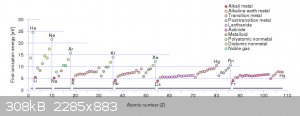Fery
International Hazard
    
Posts: 1026
Registered: 27-8-2019
Location: Czechoslovakia
Member Is Offline
|
|
anomalies in chemistry
Please post here anomalies in chemistry.
Searching the forum, I found only this one post concering density of H2O2 + H2O here:
https://www.sciencemadness.org/whisper/viewthread.php?tid=10...
my contribution:
density of water
density of solid < density of liquid
maximal density of water at 3.98 °C
(life in water)
vanillin m.p. 81-83 °C > ethylvanillin m.p. 76 °C
(longer molecule usually higher m.p.)
(b.p. are without anomaly 285 °C < 295.1 °C)
aliphatic α-monoacids m.p.
C1 (formic) 8.4 °C
C2 (acetic) 16 - 17 °C
C3 (propionic) –21 °C
C4 (butyric) −5.1 °C
C5 (valeric) −34.5 °C
C6 (caproic) −3.4 °C
C7 (enanthic) −7.5 °C
C8 (caprylic) 16.7 °C
C9 (pelargonic) 12.5 °C
C10 (capric) 31.6 °C
solubility in water of linear α,ω-dicarboxylic acids - https://azelaic.com/how-can-we-help/process-azepur99/
C2 (oxalic) 220 g/l (25 °C)
C3 (malonic) 763 g/l (25 °C)
C4 (succinic) 83 g/l (25 °C)
C5 (glutaric) 639 g/l (20 °C)
C6 (adipic) 14 g/l (20 °C)
C7 (pimelic) 50 g/l (20 °C)
C8 (suberic) 12 g/l (20 °C)
C9 (azelaic) 2,1 g/l (20 °C)
C10 (sebacic) 0,1 g/l (20 °C)
(here a zigzag scheme visible, no anomaly if you sort them in odd/even orders: in array [C2, C4, C6, C8, C10] it is [220, 83, 14, 12, 0.1], in array
[C3, C5, C7, C9] it is [763, 639, 50, 2.1]
inverted solubility curve of some sulphates in water: CaSO4, MnSO4, Ce2(SO4)3 - https://sci-hub.tw/10.1021/ed016p183
|
|
|
Swinfi2
Hazard to Others
  
Posts: 131
Registered: 19-2-2018
Location: England
Member Is Offline
Mood: Catalytic
|
|
There is a logic to every anomaly in chemistry, once you understand the logic they are no longer anonymous. But looking for them is a great way of
learning.
Take the ionization of elements:

As the atomic number increases, the growing effective charge from the nucleus increases ionization energy. But half way through each shell the energy
has a bump. Is this anonymous or predictable? Well electron pairing makes it mostly predictable.
There will always be more anomalies and more to learn the deeper you dig.
|
|
|
12thealchemist
Hazard to Others
  
Posts: 181
Registered: 1-1-2014
Location: The Isle of Albion
Member Is Offline
Mood: Rare and Earthy
|
|
Density
The density of gallium, bismuth, silicon, and germanium are all higher in the liquid phase than the solid - the solids float in the liquid
Melting point
You missed a more obvious one - benzene and toluene. Benzene melts at 6°C, toluene at -110°C. This is due to how the molecules pack in the solid
phase - symmetrical benzene forms nice stacks that slot together easily, but toluene with its methyl group doesn't pack nearly so well.
inverted solubility curve of some sulphates in water Actually, most lanthanide sulphates have that behaviour, which makes separating
Nd from the magnets comparatively simple
|
|
|
SWIM
National Hazard
   
Posts: 970
Registered: 3-9-2017
Member Is Offline
|
|
Boiling points:
Benzene and cyclohexane have similar boiling points although one has nearly twice the hydrogen atoms per unit of mass to participate in Van Der Waals
bonding.
I believe the boiling points of aromatics like benzene are higher than one would expect because they are such stiff molecules.
Cyclohexane can just flop around like mad once in the gas phase, but Benzene doesn't have that added degree of freedom when it vaporizes.
|
|
|
nezza
Hazard to Others
  
Posts: 324
Registered: 17-4-2011
Location: UK
Member Is Offline
Mood: phosphorescent
|
|
The classic ones are Ammonia, Water and Hydrogen fluoride. All have much higher boiling points than expected and way higher than the next ones in the
series, Phosphine, Hydrogen sulphide and hydrogen chloride. Largely explained by hydrogen bonding. Water is further anomalous in that solid water is
less dense than cold liquid water.
If you're not part of the solution, you're part of the precipitate.
|
|
|
j_sum1
Administrator
       
Posts: 6333
Registered: 4-10-2014
Location: At home
Member Is Offline
Mood: Most of the ducks are in a row
|
|
Electron configurations of first row transition metals...
Cr and Cu break the expected trend.
Sc — 4s2 3d1
Ti — 4s2 3d2
V — 4s2 3d3
Cr — 4s1 3d5
Mn — 4s2 3d5
Fe — 4s2 3d6
Co — 4s2 3d7
Ni — 4s2 3d8
Cu — 4s1 3d10
Zn — 4s2 3d10
Second row transitions are even more unpredictable but the third row settles down a bit.
Of course there exist logical explanations for these apparent anomalies. But these invoke higher principles than the rules that govern configurations
for all lighter elements. The patterns emerging from the first 20 elements would not cause us to predict this behaviour.
|
|
|